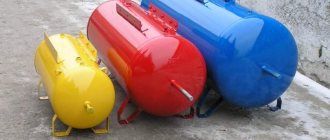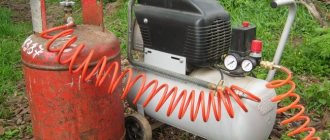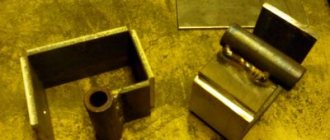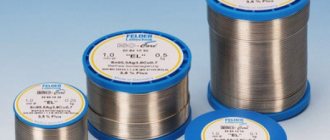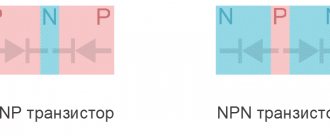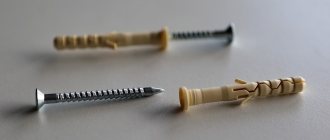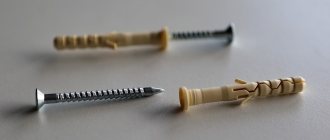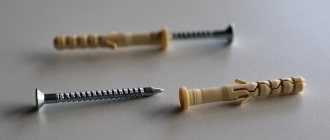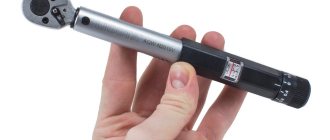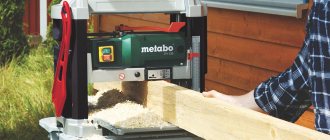An attentive buyer will notice that most factory compressors offered on the market are additionally equipped with cylinders of different cylindrical shapes and capacities. Some installations are offered without them. “What are these containers for and is it worth purchasing them for your compressor?” - we will look into this in this article.
These cylinders are called receivers and are pressure vessels. Containers that fall into this category must be tested and meet specific requirements and regulations. Color and shape in this case do not matter, but the thickness of the wall of the cylinder and its volume are significant technical parameters. The receiver equipped with the compressor unit performs several functions. Let's take a closer look at some of them to understand why it is needed.
Receiver - sump
When the compressor operates for a long time, the air supplied through its discharge pipe has an increased temperature in contrast to the ambient temperature. Therefore, when it comes into contact with the metal surface of the container, it condenses into water. Moreover, the compressed air pumped by a piston-type compressor often contains fine droplets of oil. All that moisture and oil won't do any good to the compressed air line or the air tools. They linger at the bottom of the receiver and are easily removed through the condensate drain valve, which is located at the lowest point of the container. So, the first and simplest purpose of the receiver is as a sump that cleans compressed air from unnecessary impurities.
Types of equipment
Compressor receivers can be vertical or horizontal. Containers of the first type are more in demand because they are compact in size and allow rational use of the production area.
Equipment examples
Model: RV 900-02/10 451 000 rub.
Model: V500 11B galvanized RUB 89,656
Model: RV 110/10 RUB 23,050
All models
All air collectors, regardless of configuration, can be easily combined into a common network if necessary. Moreover, installation can be performed in two methods - parallel and sequential. Each method has its pros and cons.
Equipment examples
Model: RV 900-02/10 451 000 rub.
Model: V500 11B galvanized RUB 89,656
Model: RV 110/10 RUB 23,050
All models
Parallel connection
The advantage of this installation method is the high maintainability of the system. If one of the receivers fails, it is simply disconnected from the overall system and repaired or replaced. In addition, this method provides maximum storage throughput.
Serial connection
The main advantage of this installation option is the additional cleaning of the working environment from moisture and oil impurities. Compressed air sequentially passes through all containers in the network and is cleaned along the way. As for the disadvantages of such a connection, they include the total resistance of the receivers, which reduces their throughput.
Receiver - storage
Most pneumatic devices operate with a wide range of compressed air, the pressure of which can range from 0.2 to 1 MPa. Therefore, the receiver is often used as a storage device for uninterrupted supply of air under pressure to a working pneumatic tool. This ensures continuous operation of devices powered from the pneumatic line. It also creates an optimal cyclic operating mode for the compressor with long periods of inactivity and short-term activation to build up the required pressure. To ensure safe operation of the compressor unit, the receiver is equipped with:
- a pressure gauge for measuring air pressure;
- check valve;
- a safety or relief valve to reduce the pressure in the container to a safe level.
3 Options for connecting a compressor with a receiver
One or more air collectors can be connected to one compressor. You can connect them to the device in two ways: alternate (serial) connection or parallel.
1. Serial connection
is a scheme where one receiver is connected to a compressor, and the rest are connected one after another in a chain. This scheme helps to completely eliminate vibrations in the system, eliminate pulsation and obtain additional cleaning of the working environment. But this connection has its downsides:
- Each of the receivers has its own resistance, therefore, during the operating process in the system, the overall throughput is reduced. In this connection diagram, the total throughput of all receivers is equal to the minimum throughput of one unit.
- If one receiver breaks down, the entire system will need to be shut down for repairs or one air collector will need to be replaced.
2. Parallel connection
– a diagram in which each of the receivers has its own connection to the compressor apparatus. The connection is used for technological processes with stable and intensive consumption of compressed gas. In this case, each receiver is used as efficiently as possible, since the throughput of the system will be equal to the sum of the throughputs of all connected air collectors.
Receiver - damper device
While rotary and screw compressors are characterized by softer and smoother operation, piston compressors supply air in a jerky manner. When pumping up the slope of a car, this will not create any particular inconvenience, but it will have an undesirable effect on the operation of a pneumatic tool or the result of painting the surface with a spray gun. Thus, the receiver dampens air pulsation during operation of the compressor, as well as when it is turned on. The degree of pulsation damping or smoothing depends on the volume of the receiver on the compressor, which should be 15-25% of the installation capacity, measured in l/min. For example: for a compressor with an air supply of 200 l/min, a receiver with a volume of 50 l is needed, and for a unit with a capacity of 500 l/min, the optimal solution is a 100 liter cylinder.
1What is an air receiver and what is it for?
Air receiver or air collector
– a special tank for temporary storage of compressed gas during peak load periods before its further preparation (filtration, drying) or immediately before use.
Theoretically, a pneumatic system can operate without an air collector.
For example, in industries where a constant and stable supply of working fluid is not required. In such cases, the use of filters and dryers will be mandatory, otherwise the compressor unit will quickly fail. In the process of turning the compressor on and off, a certain number of load and unload cycles of the device invariably occur. The cycles directly depend on changes in the need for compressed air at each enterprise, for example, when several consumers are simultaneously connected to one pneumatic network. As a result, pressure differences and air pulsations occur, and the compressor begins to work more intensely at increased loads. To prevent such phenomena, air after compression must be “dumped” into special containers in order to stabilize the pressure in the pneumatic network.
This leads to the second important function of air collectors - they help stabilize the control of the compressor, eliminating pressure fluctuations in the system and short on-off cycles.
Other important functions of the receiver:
- Additional cooling of the working environment and dehumidification of condensate. When air enters the receiver after compression, it naturally cools, during which condensate settles on the walls of the receiver and flows down. Thus, the receiver works as a second dehumidifier.
- Protection of equipment from corrosion. Due to the formation and accumulation of condensate in the receiver, the pipeline and other devices of the pneumatic network are more protected from corrosion due to moisture.
- The accumulation of compressed air in the receiver allows you to reduce the number of compressor on/off cycles and ensure a uniform supply of gas to the consumer.
- Reduced air pulsation and engine vibration. Reducing vibration leads to a decrease in the level of noise “pollution” of the working area, and allows you to keep the floor base longer without destruction.
- Preventing disruptions in the production process.
- Neutralization of turbulence in the working environment resulting from changes in pressure and temperature.
- Additional purification of compressed air. Large dry particles are retained along with the condensate and are then discharged outside.
- Reducing overall production costs for drying and cleaning compressed air.
The receiver can be supplied as a separate device (Figure 2):
Or supplied already complete with the compressor. This configuration is intended for premises with limited space or for small production tasks where the accumulation of large volumes of compressed gas is not required (Figure 3):
Or supplied already complete with the compressor. This configuration is intended for premises with limited space or for small production tasks where the accumulation of large volumes of compressed gas is not required (Figure 3):
Compressors with a built-in receiver have compact dimensions, high reliability, low noise and vibration levels. With their help, you can rationally use the production area. Most often, this configuration is found in compressors with a power of up to 26 kW.
How do receivers affect the efficiency of the production process?
Using a receiver in a pneumatic network allows you to increase the efficiency of all equipment. This happens due to the fact that the air collectors:
- Reduce pressure on the compressor. The air collector reduces critical pressure levels. This increases the efficiency of the equipment, since every 0.29 kPa increase in pressure leads to a loss of 1% of energy and increased load on the engine.
- They reduce the number of “on/off” operating cycles, thereby almost completely eliminating the loss of compressed air when unloading the compressor during system purging.
- Reduces the load on the dehumidifier. Due to the formation of condensate, which is discharged through a special tap in the receiver, the air enters the dehumidifier without foreign particles and is almost completely dry. This reduces the load on the dryer.
Price on request
Request CP
Write by email
We offer receivers with pressures of 10-16-40 bar and tank volumes from 3 to 900 liters. Receivers with a volume of 250-500-900 liters are always available. Go to section >>>
Types of receivers and their scope of application
The air collector is used as part of compressor stations (CS), nitrogen, ammonia and refrigerant installations for storing and producing compressed air, nitrogen, oxygen, etc.
Air receivers are:
- linear. They are installed between the control valve and the condenser. Such receivers serve to compensate for differences in the liquid filling of evaporative equipment during heat load surges. By freeing the condenser from liquid, they create a flow of liquid agent moving evenly to the control valve. The refrigerant, maintained at the same level, becomes a hydraulic seal that prevents steam from flowing into the evaporator.
- protective. They are installed below a certain level where the evaporation system equipment is located. Designed for draining liquid from liquid separators and evaporators in pumpless refrigerant supply systems.
- drainage (RD or RDV). Such receivers are needed to drain liquid refrigerant from pipelines and refrigeration units during their repair and during their operation. circulation (RCZ and RCC). Reservoirs that are filled with liquid refrigerant are designed to ensure continuous operation of the circulation pump that supplies liquid to the evaporators.
- Circulating air receivers are used in pump-circulating units for supplying liquid refrigerant to evaporative systems. Air drainage receivers RD are used as protective, drainage, linear and circulation receivers; RDV vertical air receivers are used as circulation and protective receivers.
You can find out the prices for air receivers sold by AIRTECHNO LLC in the price list.
How to choose the optimal receiver parameters
Like any technical product, the receiver has a number of technical parameters. Among them are:
- Volume, l.
- Humidity.
- Operating parameters, that is, limit values of humidity and temperature.
- Characteristics of the installation location of the compressor unit. It must be installed away from sources of heat, fire and explosive substances. The presence of foreign particles in the air is undesirable, for example, in procurement areas.
Safety rules state that it is unacceptable to use receivers that have not passed the appropriate test, on the surface of which there are mechanical damage in the form of cracks and traces of corrosion.
The selection of a receiver is carried out on the basis of a fairly simple calculation:
- The required flow rate of the air mixture, the duration of the flow rate, and the maximum operating pressure are determined.
- Using special calculation tables, they exist both in paper form and as Internet applications. For example, with a productivity of 0.1 cubic meters per minute, a maximum load duration of 5 minutes and within a pressure range of 3/4 (min/max), the volume of the receiver will be about 500 liters.
This method of calculation is focused on the time required to completely empty the container.
There is another technique based on the ratio of the volume of the vessel and the power of the air compressor. In practice, the following ratios are used:
- Power 5 kW, volume max – 100 l.
- Power 10 kW, volume max – 300 l.
- Power 20 kW, volume max - 550 l.
There are also experimental dependencies, for example, the volume of the receiver cannot be less than the amount of air that the compressor can produce for 8 seconds of operation. For example, the flow rate is 400 liters per minute, respectively, the volume of the poppy must be at least 53 liters.
Here you can select and buy air receivers for compressors.
Why do you need a receiver in a compressor?
Equipment for the production of compressed air is used everywhere. It is used in all industries, during construction work, in auto repair, in food production, in agriculture, as well as in any other areas of activity of modern man. In the vast majority of cases, the units are used in conjunction with a receiver - a metal vessel into which compressed air enters. These reservoirs are also widely used and therefore deserve a more detailed consideration.
Do-it-yourself additional receiver for a compressor
Some work performed in a home workshop or garage requires compressed air. And a situation may arise when a household compressor cannot cope with the task. In this case, the situation can be resolved by installing an auxiliary receiver on the existing unit. This device can either be purchased at a specialized store, for example, car spare parts. There you can buy a receiver for the KAMAZ pneumatic system, or make it yourself.
Most of the receivers offered are made for a specific model and are distinguished by a high price. Depending on the planned size of the DIY container, you can use either a propane cylinder or a fire extinguisher body.
